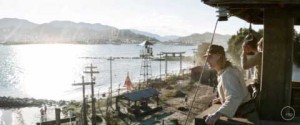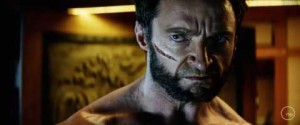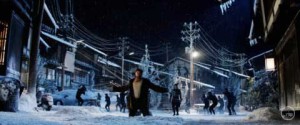 Australian VFX house Rising Sun Pictures (RSP) recently delivered more than 260 visual effects shots for The Wolverine – the new action film from director James Mangold and Twentieth Century Fox. RSP helped to recreate the World War II atomic bomb attack on Nagasaki, Japan. It also produced digital environments for a number of sequences, including a scene set in a snow-covered Japanese village, and combat effects such as digital copies of Wolverine’s iconic claws for use in numerous scenes involving stunts.
Australian VFX house Rising Sun Pictures (RSP) recently delivered more than 260 visual effects shots for The Wolverine – the new action film from director James Mangold and Twentieth Century Fox. RSP helped to recreate the World War II atomic bomb attack on Nagasaki, Japan. It also produced digital environments for a number of sequences, including a scene set in a snow-covered Japanese village, and combat effects such as digital copies of Wolverine’s iconic claws for use in numerous scenes involving stunts.
The work was conducted under the supervision of the production’s VFX supervisor Philip Brennan and VFX producer Jamie Stevenson. RSP’s team was led by VFX supervisor Tim Crosbie.
“RSP was one of the primary vendors on The Wolverine and they brought a great deal to the table both creatively and technically,” said Stevenson. “Having worked with them in the past, we knew they would be a great fit for much of the claw work, but we also felt that they were the right vendor to take on several of the key sequences that required extensive environment work as well as challenging simulations and particle effects.”
 For the atomic bomb attack, which occurs in an early flashback sequence, RSP artists worked from archival footage to produce a CG model of Nagasaki and the towering mushroom cloud produced by the bomb. They also created pyroclastic shock waves and debris elements for shots showing the destruction of the prisoner of war camp where Wolverine is being held.
For the atomic bomb attack, which occurs in an early flashback sequence, RSP artists worked from archival footage to produce a CG model of Nagasaki and the towering mushroom cloud produced by the bomb. They also created pyroclastic shock waves and debris elements for shots showing the destruction of the prisoner of war camp where Wolverine is being held.
“The view of Nagasaki, seen from across a harbor, required an extensive digital matte painting,” explained Crosbie. “We started by modelling the bomb after photographs of the actual blast, but James Mangold wanted something unique and so pushed the blast into something never before seen. We were able to leverage research we had done for previous destruction effects to make an event that is much, much bigger and more immersive. It’s exciting stuff.”
RSP built a detailed 3D model of the prisoner of war camp on location in Sydney, and then blew it apart as the radioactive shock waves roll through. One of those waves carries Wolverine through the air. He lands in a stone well where he uses his body as a shield in saving the life of a Japanese soldier.
 “Components of the huts and wood that fly past the camera required a fair amount of choreography and numerous iterations to get the action beats just right,” said Crosbie. “Equally challenging was the pyroclastic cloud – the leading edge of the explosion – which sweeps across city and the water and through the camp ripping up buildings, guard towers and everything else in its path.”
“Components of the huts and wood that fly past the camera required a fair amount of choreography and numerous iterations to get the action beats just right,” said Crosbie. “Equally challenging was the pyroclastic cloud – the leading edge of the explosion – which sweeps across city and the water and through the camp ripping up buildings, guard towers and everything else in its path.”
The Japanese Village scene, where Wolverine is attacked by an army of Ninjas, also required extensive visual effects enhancement. Live action was shot on a partial set built in a Sydney car park. RSP extended the set considerably with CG buildings and mountain ranges. High, wide-angle views of the village are fully CG. Artists also created the torrent of arrows with ropes that are fired by ninjas at Wolverine in order to capture him. “The process involved identifying each of the ninjas and determining when each would fire,” Crosbie explained. “We match-moved a detailed CG model of Wolverine and used that to drive the arrows, rope dynamics and choreography of the scene. Once we knew where the arrows were coming from and going to, it was straightforward for the animators to work out the timing and hit their marks.”
Digital replacements for Wolverine’s claws were used in place of practical claws for scenes involving dangerous stunts. In those instances, actor Hugh Jackman wore stubs or tracking markers that served as guides for match-moving the digital claws. “Philip Brennan provided us with a full HDRI set for every shot requiring visual effects, so we knew exactly what lighting was required,” Crosbie noted. “That worked extremely well. Each claw was rendered out with an option of blood stained or cleaned, so at a moments notice we could make a scene gory or safe.”
Other items on RSP’s task list included adding wounds to Wolverine during some of his many fights, filling a bucket with a murky liquid that one of Wolverine’s adversaries uses to create poison arrows, massive set extensions replacing iconic Sydney landmarks with iconic Japanese structures. Artists also created a matte painting and environmental elements for a scene set in Canada’s Yukon as well as all shots of the Yashida lab.
“We really appreciated how efficiently RSP handled the workflow for the show overall,” said Stevenson. “No matter what we threw at them, we never ruffled their feathers. Even last minute adds and changes were all accommodated with a positive attitude.”






